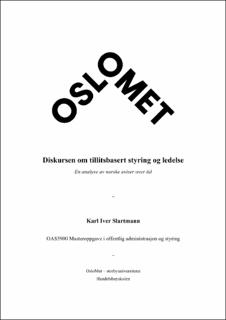| dc.description.abstract | This master’s thesis seeks to map the discourse on trust-based management and leadership (TBML) in some of the largest Norwegian newspapers. Namely to assess 1) the Norwegian discourse compared to tendencies otherwise in Scandinavia, 2) which actors are most active within the discourse, 3) the terminology used to frame TBML, as well as aspects of the newspapers, 4) attitudes towards TBML and their development, and 5) the development in the spread (mention) of TBML over time. Over 180 newspaper articles have been selected, covering a period of eleven years (2010-2020). They are registered and analyzed by utilizing a combination of quantitative and qualitative content analysis. Concepts from discourse analysis are drawn upon throughout. The results are viewed and discussed within the frame of the initial five-part division of focal areas and discussed in light of relevant theory on the fields of trust, discourse, and the spread of management and leadership ideas.
The findings indicate that the Norwegian discourse gains momentum simultaneously as the rest of Scandinavia, though with a few more odd peaks in mention, related to specific, highly politicized and debated topics. By sector, political representation and attitudes, the actors that are most active within the discourse are political, social-democratic and positive towards TBML. The most positive actors towards TBML, by level of position, are political and public leaders. I tie these individual groupings of actors to different theoretical contributions on the spread of management ideas, hereunder diffusion theory, the translation of ideas, the life-cycle perspective, and the analogy of resistance. Pronounced negative mention of TBML does not occur, however, TBML is often problematized by individual actors through a line of thought that sees “trust” as a phenomenon that cannot be united with a professional reality that calls for control. The problematization of TBML is also more frequent in regional newspapers and by actors on employee level.
The findings also indicate that the shift in conceptual focus from “leadership” exclusively, to “management (steering) and leadership” over the last three years, results from a process of learning. “Steering” as a counter-concept, paradoxically becomes more common at the same time. This is tied to the leader-employee division and its impact on the spread, reception and implementation of ideas. To the degree the spread of TBML can be mapped by article frequency over time, it seems to follow an S-shaped diffusion line. However, other important aspects than the visual development in article frequency are in line with different approaches to the spread of management ideas, as highlighted throughout the analysis. | en_US |
